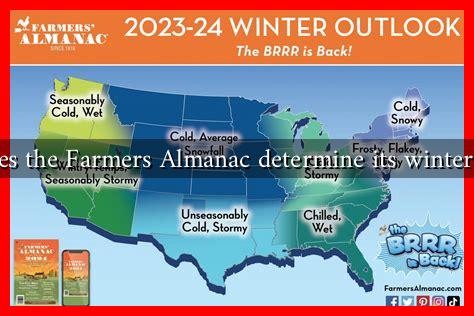-
Table of Contents
How Does the Farmers’ Almanac Determine Its Winter Forecast?
The Farmers’ Almanac, a time-honored publication that has been predicting weather patterns since 1818, is renowned for its long-range forecasts. Each year, millions of people turn to this almanac to prepare for the winter months. But how does the Farmers’ Almanac arrive at its predictions? This article delves into the methodologies, historical context, and unique approaches that the Farmers’ Almanac employs to forecast winter weather.
The Historical Context of the Farmers’ Almanac
The Farmers’ Almanac was founded by David Young, a mathematician and astronomer, who initially aimed to provide farmers with essential information for planting and harvesting. Over the years, it has evolved into a comprehensive source of weather forecasts, gardening tips, and lifestyle advice. The almanac’s predictions are based on a combination of historical data, astronomical phenomena, and meteorological patterns.
Methodologies Used in Forecasting
The Farmers’ Almanac employs a unique blend of traditional and modern forecasting techniques.
. Here are some of the key methodologies:
- Historical Weather Patterns: The almanac analyzes weather data from previous years to identify trends and patterns. This historical context is crucial for understanding how similar conditions may affect future weather.
- Astronomical Influences: The almanac considers the positions of the sun, moon, and planets. These celestial bodies can influence weather patterns, and their movements are factored into the forecasting process.
- Mathematical Formulas: The Farmers’ Almanac uses proprietary mathematical formulas developed over decades. These formulas take into account various meteorological factors, including temperature, precipitation, and atmospheric pressure.
- Seasonal Indicators: Certain natural indicators, such as animal behavior and plant cycles, are also observed. For example, if animals are seen gathering food earlier than usual, it may suggest a harsher winter ahead.
Case Studies: Successful Predictions
The Farmers’ Almanac has garnered a reputation for its accuracy in predicting extreme weather events. Here are a few notable examples:
- Winter of 2014-2015: The almanac predicted a “polar coaster” winter, which was characterized by extreme temperature fluctuations and heavy snowfall across much of the United States. This forecast was validated by the severe winter conditions that ensued.
- Winter of 2020-2021: The Farmers’ Almanac forecasted a cold and snowy winter for the Midwest and Northeast, which aligned with the actual weather patterns experienced during that season.
Limitations and Criticisms
While the Farmers’ Almanac has a loyal following, it is not without its critics. Some meteorologists argue that the almanac’s methods lack scientific rigor compared to modern meteorological techniques. Key criticisms include:
- Reliance on Historical Data: Critics argue that past weather patterns may not always predict future conditions accurately, especially in the context of climate change.
- Lack of Real-Time Data: Unlike modern forecasting methods that utilize satellite imagery and real-time data, the almanac’s predictions are based on historical averages and astronomical calculations.
Conclusion: The Farmers’ Almanac’s Unique Place in Weather Forecasting
The Farmers’ Almanac remains a beloved resource for many, offering a blend of tradition and unique forecasting methods. While it may not always align with modern meteorological practices, its historical context and time-tested techniques provide a fascinating perspective on weather prediction. As winter approaches, the almanac continues to serve as a guide for farmers, gardeners, and anyone looking to prepare for the season ahead.
In summary, the Farmers’ Almanac’s winter forecasts are determined through a combination of historical data analysis, astronomical influences, and proprietary mathematical formulas. Despite facing criticism, its successful predictions over the years highlight its enduring relevance in the realm of weather forecasting. For more information on the Farmers’ Almanac and its predictions, visit their official website at Farmers’ Almanac.





